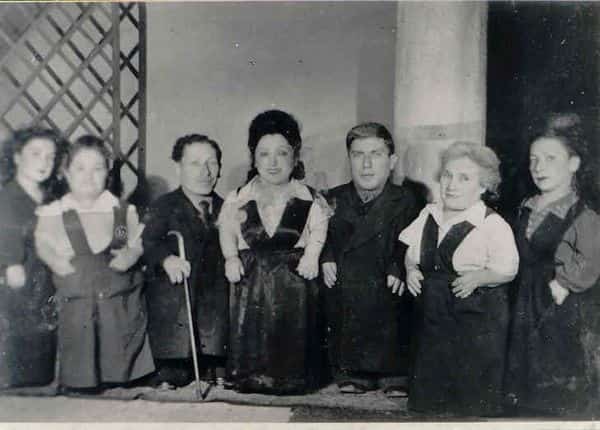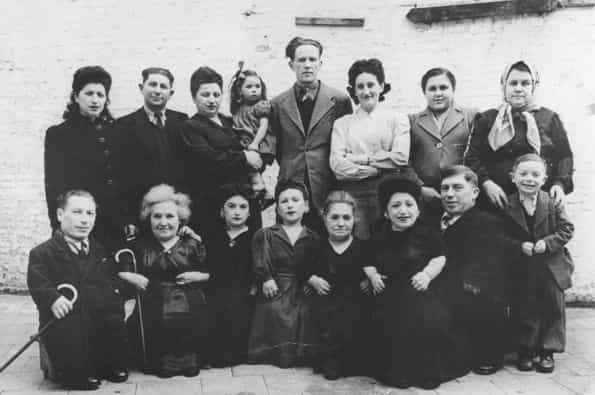The Ovici Family: A Remarkable Story of Survival and Resilience

The Ovici (also known as Ovitz) family holds a unique and powerful place in history. Known as the largest documented family of dwarves, they not only defied physical limitations but also survived one of history’s darkest chapters together.
Their journey, from a small town in Transylvania to the horrors of Auschwitz and eventually a new life in Israel, is a testament to resilience, family strength, and survival against all odds.
The Origins of the Ovici Family
The Ovici family’s story begins in Rozavlea, a village in northern Transylvania near Sighet. The family patriarch, Shimshon Eizik Ovici, was born in 1868 and, like many in his family, was a dwarf. Standing only around three feet tall due to a form of dwarfism called pseudoachondroplasia, Shimshon faced physical challenges but found his calling as a *badchan*, or Jewish wedding entertainer. Later in life, he became a traveling rabbi across the Maramures region.
Shimshon married Blanca, an average-height woman, and together they had two dwarf children, Rozika and Francesca. Sadly, Blanca passed away at a young age, leaving Shimshon a widower. He remarried another average-height woman named Batia, and they went on to have eight more children. Of these, five were dwarves—Avram, Frieda, Micki, Elizabeth, and Perla—and three were of average height: Arie, Sarah, and Leah.
The Importance of Family Bond and Unity
Family was central to the Ovici’s survival, not only emotionally but also practically. The close-knit family faced challenges and discrimination in societies that were often unkind or even hostile toward people who looked different. Understanding the importance of unity, Batia encouraged her children to build a skill together to help them earn a living as a group. This not only helped them avoid social isolation but also provided a sense of purpose and belonging.

Life with Pseudoachondroplasia
The Ovici family’s type of dwarfism, pseudoachondroplasia, presented both physical and social challenges. Standing only around three feet tall, the family members couldn’t take on physical labor, which was the main source of work for many in rural Transylvania. Recognizing these limitations, Batia encouraged her children to pursue the arts as a way to support themselves. With practice and passion, the family developed a skill that would later become a source of both income and survival.
The Birth of the Lilliput Troupe
With encouragement from their mother, the Ovici siblings formed a unique performance group known as the “Lilliput Troupe.” Combining music, comedy, and theater, they entertained audiences across Czechoslovakia, Hungary, and Romania. Playing child-sized instruments and wearing costumes tailored to their stature, the troupe quickly became a popular act. While the seven dwarf siblings performed, the average-height family members assisted backstage, creating a seamless and professional show.
The Lilliput Troupe was more than a source of income; it gave the Ovici family a sense of identity, purpose, and community. Their performances allowed them to find acceptance and admiration in a world that often looked upon people with dwarfism with curiosity, misunderstanding, or prejudice.
Surviving Under Hungary’s Racial Laws
The Ovici family’s life was further complicated by the political changes in the region. In 1940, Hungary annexed northern Transylvania, implementing strict racial laws. As a Jewish family, the Ovici’s faced increasing danger and limitations. Despite these challenges, they managed to obtain identification papers that did not mention their religion, allowing them to continue performing for a few more years. This delicate balancing act of hiding their identity to survive while maintaining their artistry kept them going until 1944.
Deportation to Auschwitz
In the spring of 1944, German forces occupied Hungary, and the Ovici family’s luck ran out. They were captured and, along with many other Jewish families, deported to Auschwitz on May 12, 1944. The Ovici’s were thrown into an environment that was not only physically and emotionally grueling but also potentially deadly. The family’s arrival at Auschwitz marked the beginning of one of the darkest periods in their lives.
Dr. Joseph Mengele’s “Interest” in the Ovici Family
The Ovici family’s unique physical appearance caught the attention of Dr. Joseph Mengele, the infamous Nazi doctor known for his cruel medical experiments on prisoners. Mengele had a perverse interest in the Ovici family, fascinated by their shared form of dwarfism and eager to study them for his twisted research.
Though Mengele subjected the family to disturbing medical experiments, his “interest” ironically contributed to their survival. The Ovici’s were treated differently from the other prisoners, and this distinction, albeit for sinister reasons, allowed them to survive the brutal conditions of Auschwitz together.
Liberation and the Aftermath of Auschwitz
On January 27, 1945, Auschwitz was liberated, and the Ovici family was among those freed from the camp. After enduring a harsh winter and months of starvation, the family was finally safe from the horrors of the concentration camp. Their ordeal, however, was far from over. The liberated Ovici family was initially sent to the Soviet Union before being allowed to return to their home in Rozavlea in August 1945.
Rebuilding Their Lives in Israel
After returning to Rozavlea, the Ovici family found it difficult to resume their lives in a region scarred by war and loss. Seeking a fresh start, they moved to Antwerp and, in May 1949, immigrated to Israel. Settling in Haifa, the family tried to rebuild their lives and establish a sense of normalcy. True to their roots, they revived the Lilliput Troupe and began performing again, bringing joy to audiences despite the hardships they had endured.
Continuing the Lilliput Troupe in Israel
In Israel, the Lilliput Troupe resumed its performances, which had become even more meaningful. The Ovici family had gone through an unimaginable ordeal, and their art was now both a means of healing and a testament to their resilience. Their performances symbolized hope and the triumph of the human spirit over oppression. They continued performing until their retirement in 1955, marking the end of an era for the remarkable family troupe.
Legacy and Historical Significance
The Ovici family’s story is a powerful example of resilience, survival, and the strength of family bonds. Their legacy is not only preserved in records but also serves as an inspiring reminder of the human capacity to overcome adversity. Despite being one of the most marginalized groups in society, the Ovici family used their talents and close family bonds to create a life of dignity and purpose.
The Ovici family’s journey from their small village in Transylvania to the concentration camps and ultimately to Israel is nothing short of extraordinary. Their resilience in the face of unimaginable challenges, their unity as a family, and their determination to keep their art alive make their story one of the most compelling tales of survival. Through their performances and their spirit, they left a lasting impact on history—a story that continues to inspire and remind us of the strength of the human spirit.
Here are some FAQ questions and answers to complement the article:
1. What kind of dwarfism did the Ovici family have?
The Ovici family members who were dwarves had a condition known as pseudoachondroplasia. This type of dwarfism affected their height and physical abilities, preventing them from performing strenuous labor and making everyday tasks more challenging.
2. How did the Ovici family survive Auschwitz?
The Ovici family’s survival in Auschwitz is largely attributed to Dr. Joseph Mengele’s interest in their unique physical condition. While his interest subjected them to disturbing medical experiments, it also meant they were not sent to gas chambers or labor camps, which ultimately increased their chances of survival.
3. What was the Lilliput Troupe?
The Lilliput Troupe was a musical and comedy act formed by the Ovici family. With child-sized instruments and a mix of music and comedy routines, they performed across Europe before World War II. Their talents not only provided income but also helped them stay connected as a family.
4. What happened to the Ovici family after the war?
After the liberation of Auschwitz in 1945, the Ovici family returned briefly to their village before relocating to Antwerp and later immigrating to Israel in 1949. They settled in Haifa, where they revived their Lilliput Troupe and performed until their retirement in 1955, continuing to share their art and resilience with new audiences.
